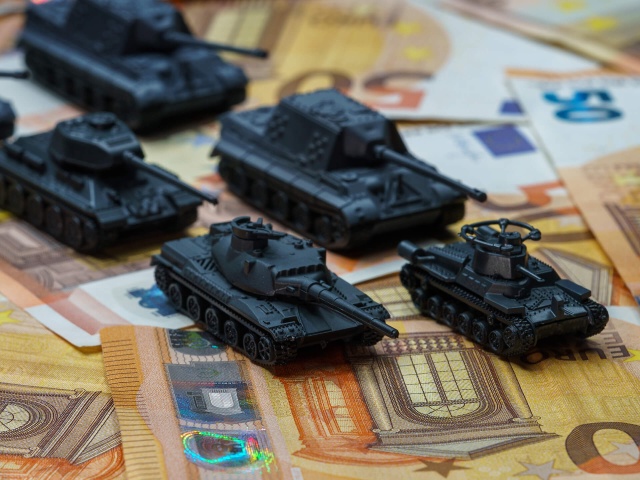Rising tensions, rising costs
In the wake of Rishi Sunak’s trip to Poland to meet Polish Prime Minister Donald Tusk and the secretary general of the NATO defense alliance, Jens Stoltenberg, the issue of global military spending has come sharply into focus.
To take Mr Sunak’s own words: we’re now on a “war footing”.
It’s got many people rightfully worried. How far will we go to “show our enemies that we are resolute and determined”, and at what cost?
Now for some numbers…
In addition to allocating a further £500 million in aid to Ukraine (in addition to the £2.5 billion already earmarked for this financial year), Mr. Sunak announced a significant £75 billion boost in defense spending and issued a challenge to other European nations to follow suit. This initiative aims to elevate the UK’s annual defense budget to 2.5% of GDP, reaching £87 billion by 2030-31, marking what he calls “the most substantial reinforcement of our national defense in a generation.” This decision mirrors a broader transatlantic discourse on the appropriate level of military investment in Europe, with NATO advocating for member states to commit 2% of their GDP to defense spending.
Experts I’ve spoken to argue that 5% of GDP should be the true benchmark. The perennial debate over defense spending often centers on higher targets. However, what remains indisputable is that irrespective of the targets set, defense spending continues to escalate.
Record spending and security dilemmas
A new report by the Stockholm International Peace Research Institute (SIPRI) paints a worrying picture. Global military spending reached an all-time high of $2443 billion in 2023, a staggering 6.8% increase from the previous year. This marks the steepest year-on-year rise since 2009, with increases observed in all five regions tracked by SIPRI.
The United States remains the world’s top military spender, accounting for roughly a third of global expenditure. Collectively, NATO countries hold well over half (around 53%) of global military spending, spending roughly 12 times more than Russia.
Several factors are driving this surge. The ongoing wars in Ukraine and Gaza, heightened tensions in the South China Sea particularly regarding Taiwan, and a general sense of global insecurity are all contributing to a global arms buildup.
This phenomenon can be understood through the concept of the “security dilemma.” When one country significantly increases its military spending, its neighbors perceive this as a threat, prompting them to boost their own defenses in response. This creates a dangerous cycle of escalation, with no clear winner and no clear counter.
It’s also worth highlighting the role of powerful military-industrial complexes in these increased spending decisions. Large defense companies wield significant influence over governments. Too many big monopolists with immense and unique capabilities that are very difficult for other companies to emulate. In a country like Britain, you have one company, BAE, producing submarines. In France, it’s a similar story. In the US, there may be two or three companies capable of building submarines but broadly speaking, anywhere across the world, any major item expenditure is dominated by one company.
The reality is that it’s unfortunately nigh-on impossible for the government to procure capability from outside the trusted few. Therefore, you have a large portion of military spending riddled with inefficiencies and wasteful practices.
The impact of rising military spending varies across regions and the way countries are spending on defense is also changing. The war in Ukraine has significantly impacted European spending, with countries near the conflict zone understandably seeking to strengthen their defenses. Additionally, there’s been a notable rise in military aid specifically directed towards Ukraine and Gaza. Congress recently agreed to the best part of $95 billion in support.
In Africa, the rise of radical Islamist groups across the Sahel region is driving increased defense spending by affected countries. However, Africa remains a relatively low spender compared to North America, Europe, and Central and Eastern Asia.
Central America and the Caribbean face unique challenges. Drug trafficking plagues Central America, necessitating increased military spending for counter-narcotics efforts. This comes at the expense of funding for social programs that could address the root causes of crime and violence.
But is it really as bad as it seems?
The human cost of prioritizing military strength globally cannot be ignored. The post-9/11 wars are a stark example. We’ve seen 900,000 people killed, another 4 million killed indirectly, 40 million people displaced and many billions of dollars spent on the conflict highlighting the millions of lives lost and displaced, alongside the immense financial burden placed on nations.
The SIPRI report raises critical questions about the world’s approach to security spending. While some experts argue it’s necessary to address current threats, others believe it reflects a misplaced priority that diverts resources from tackling other pressing global issues like climate change and human development.
However, it’s prudent to take a step back, pause and breathe. While announcements of increased spending may suggest unabated military growth, the reality may differ, as evidenced by the situation in Ukraine. Despite the UK committing £3 billion for this financial year, only a fraction has been allocated to actual projects. It turns out it’s actually quite difficult to acquire capability, especially in a rapidly moving world and ever-changing threat landscape. Just look at LAND400 in Australia.
We must also look deeper into the security dilemma. While it’s difficult, and some might argue reckless, to not increase military spending if your neighbor is doing so, there is one highly effective way of countering it.
Alliances.
The corresponding strengthening of AUKUS and other multinational alliances this month is evidence of that. It’s an asymmetrical advantage the West has over China and Russia that no money in the world can buy.
In this context, it’s reassuring to recognize that some figures may be inflated, perhaps to make our joint enemies think twice.






